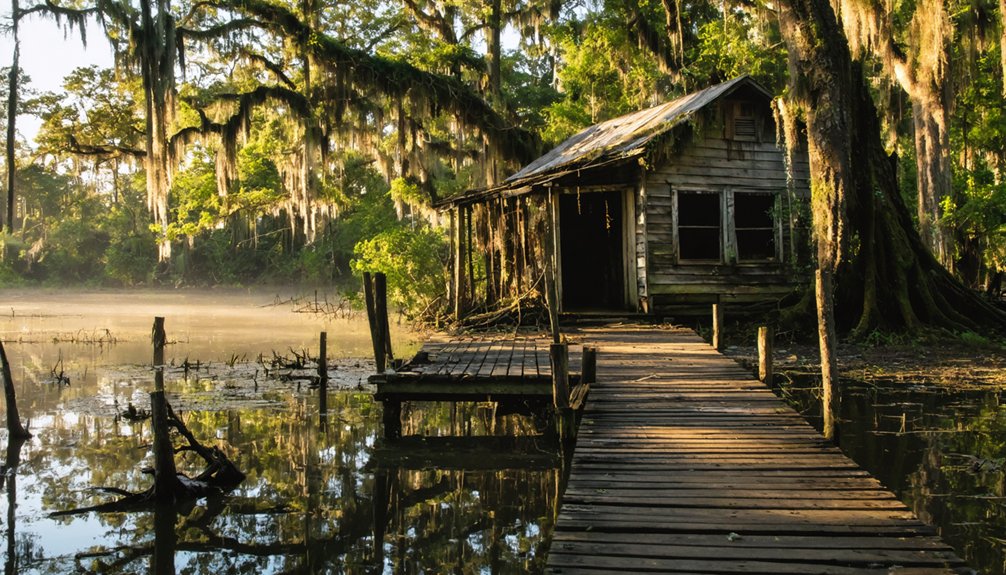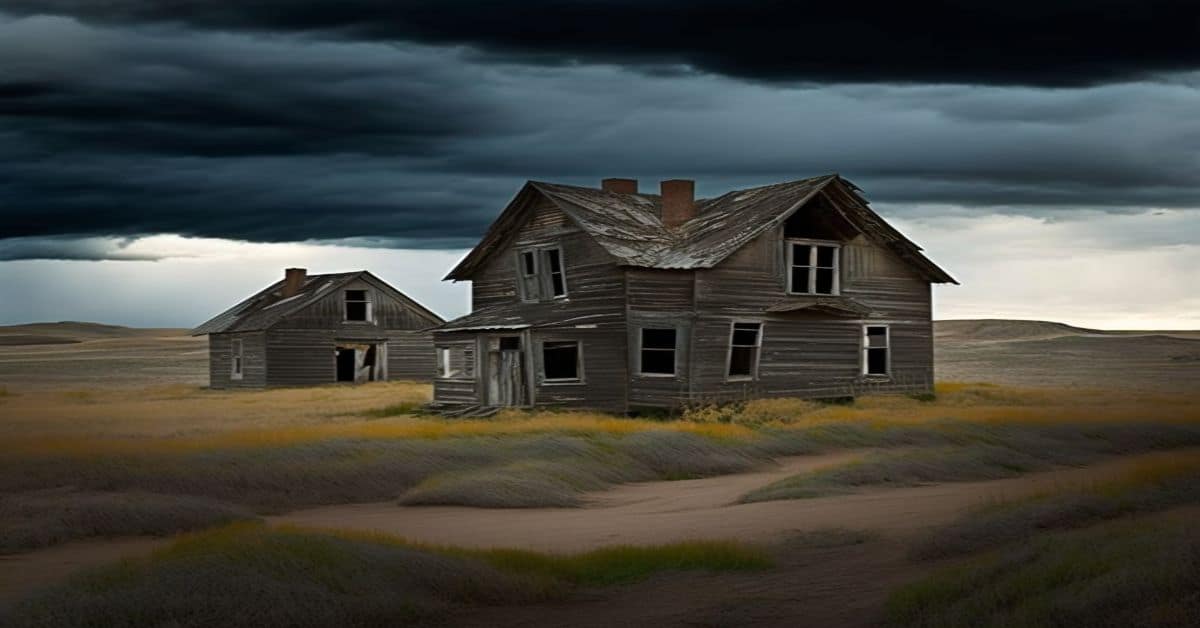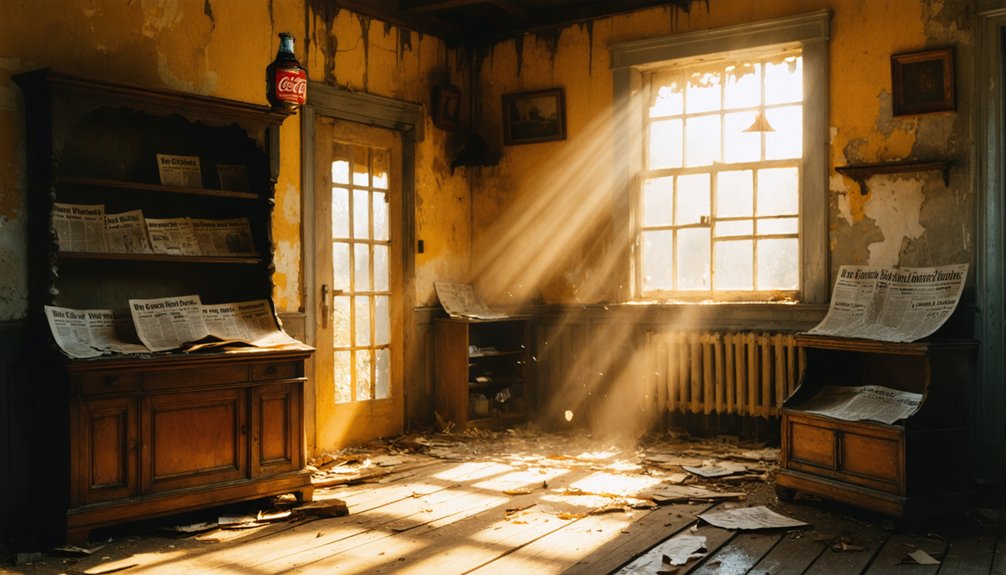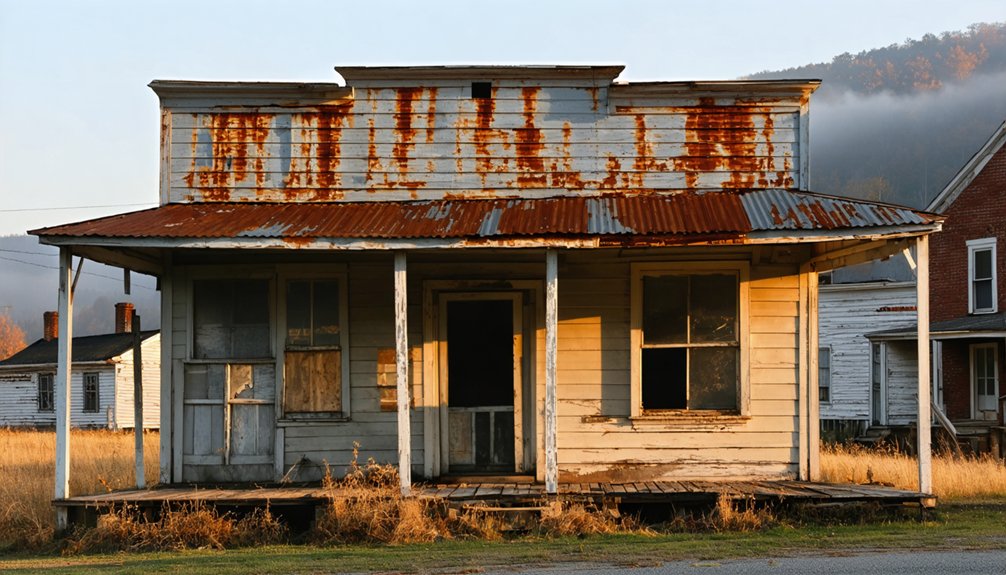You’ll find Golden Pond’s haunting story in western Kentucky, where a thriving river town met its fate in 1969. The Tennessee Valley Authority seized 170,000 acres between Kentucky Lake and Lake Barkley, forcing nearly 4,700 residents to abandon their homes. Once known for moonshine production and river trade, some residents burned their own houses rather than surrender them. Today, concrete mounting blocks and submerged foundations whisper tales of resistance, displacement, and unexplained phenomena beneath the waters.
Key Takeaways
- Golden Pond was a thriving Kentucky town established in 1848, known for timber, iron ore, and moonshine production until the 1960s.
- The Tennessee Valley Authority forcibly acquired 170,000 acres in 1964, displacing residents through eminent domain for the Land Between the Lakes project.
- Many residents burned their homes rather than surrender them, while others faced forced evictions and inadequate compensation.
- The town was completely abandoned by 1969, with all structures either burned, bulldozed, or submerged beneath Kentucky Lake and Lake Barkley.
- Today, only concrete mounting blocks remain visible, while the town’s remnants lie underwater, reportedly accompanied by paranormal activity.
Early Days of Settlement and Naming
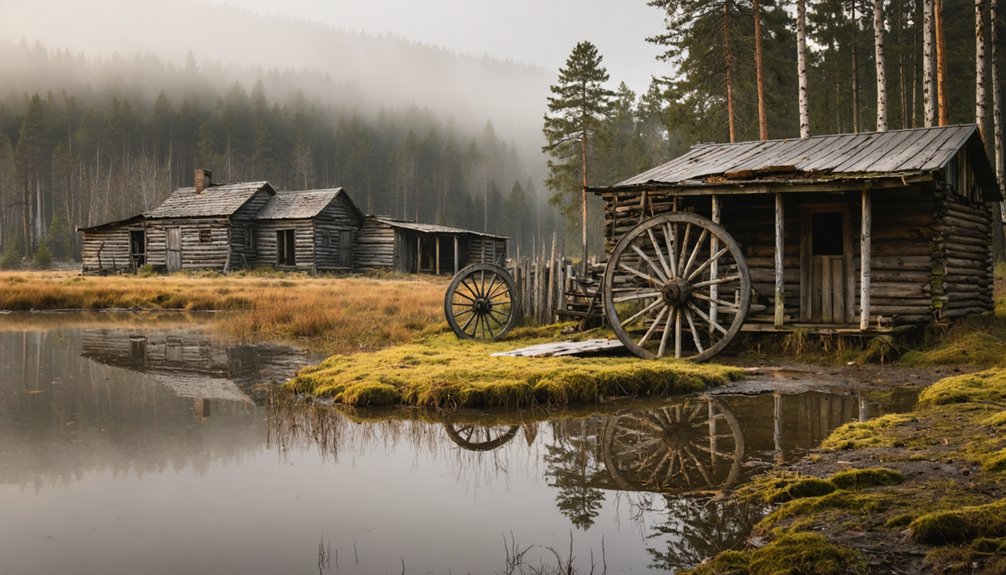
Three key developments marked the early establishment of Golden Pond, Kentucky. First, John Futrell and other early settlers arrived around 1845, establishing homesteads in an area rich with natural resources.
Then, on December 28, 1848, the town’s first post office opened near a distinctive pond that reflected golden sunlight.
Finally, a separate community called Fungo emerged around a saloon east of the original settlement.
The community dynamics of these early days revolved around two distinct settlements that would eventually merge. While the original post office sat near the namesake pond, the town’s center later shifted to the Fungo area after the Civil War. The area’s river-bottom soil and abundant timber resources contributed significantly to the town’s early prosperity.
Despite the move, the prestigious “Golden Pond” name prevailed, immortalizing the natural phenomenon that first caught settlers’ attention. The community faced adversity when two major fires struck in 1898 and 1936, but residents rebuilt each time.
The Rise of a Bustling River Town
Between the Tennessee and Cumberland Rivers, Golden Pond emerged as western Kentucky’s most dynamic trading hub during the late 19th century.
You’d find a thriving community built on timber harvesting, iron ore extraction, and fertile farmland. The town’s strategic location along the east-west road made it essential for river trade, connecting merchants and travelers across the region. During Prohibition, the town became notorious for its moonshine production operations, supplying major cities like Chicago and Detroit.
A bustling crossroads where timber, iron, and farms fueled prosperity, Golden Pond linked vital waterways and trade routes across Kentucky.
Despite devastating fires in 1898 and 1936, the community’s resilience shone through as residents rebuilt and modernized their town.
- Witness the determination of settlers who transformed two small settlements, Fungo and Golden Pond, into the area’s largest commercial center
- Experience the freedom of river life, where cool springs and abundant wildlife sustained generations
- Feel the pioneering spirit of a community that twice rose from the ashes to maintain its significant role in regional commerce
Moonshine Legacy and Prohibition Era
Golden Pond’s commercial prosperity in the late 19th century gave way to a different kind of enterprise during the Prohibition era – moonshine production.
You’d find up to 15 stills operating daily, with master distillers like Joe Bogard and Casey Jones perfecting their moonshine recipes using local corn, sugar, and the region’s pristine water.
The area’s reputation for quality caught the attention of Al Capone, who regularly ordered Golden Pond’s spirits for his Chicago operations.
Local distillation techniques involved aging the moonshine in oak barrels, creating a distinctive flavor that made it sought after in speakeasies across the Midwest.
Despite “Big Six” Henderson and other federal agents’ efforts to shut down operations, moonshiners cleverly concealed their stills in caves and remote locations, maintaining a thriving underground economy that sustained many families through hard times.
The region’s limestone spring water proved essential for crafting high-quality moonshine that helped establish Kentucky’s reputation in the underground spirits trade.
The town’s isolation between Kentucky Lake and Lake Barkley made it an ideal location for avoiding law enforcement during raids.
Economic Growth and Local Industries
While many small Kentucky towns relied on a single industry, the economic foundations of Golden Pond rested on diverse natural resources that fueled its growth through the late 19th and early 20th centuries.
You’d find a thriving local economy built on timber harvesting, iron ore extraction, and fertile valley agriculture. The town’s strategic location along major transportation routes helped local businesses flourish, with US Route 68 bringing steady traffic to the area’s shops, cafes, and motels. The construction of Kentucky Dam in 1938 created thousands of new jobs and brought significant economic stimulus to the region.
Economic diversification accelerated when Kentucky Lake’s development brought tourism opportunities to complement traditional industries.
- The rich valley soils and cool springs supported independent farmers who could live off their own land.
- Local merchants maintained their freedom from corporate control through diverse revenue streams.
- Family-owned businesses thrived by serving both residents and travelers, creating a self-sufficient community.
Life Along the Tennessee and Cumberland Rivers
The Tennessee and Cumberland Rivers shaped daily existence in Golden Pond, creating a vibrant riverine culture that defined the region’s character.
You’d find steamboats maneuvering these mighty waterways between December and May when water levels permitted, connecting isolated communities to essential trade networks.
The limestone bluffs and deep gorges carved by the Cumberland created a distinctive landscape where river folklore flourished among settlers who’d made their homes along the 600-foot-wide channel.
The rivers’ cultural influences ran deep, with communities adapting to the natural rhythms of these waterways. During winter and spring, the Cumberland River experienced heavy flooding that local residents learned to anticipate and prepare for.
You’d see boats working around Harpeth Shoals’ treacherous rocky ledges, while riverside settlements thrived on milling, mining, and agricultural activities that depended on the river’s resources and transportation capabilities.
The local economy flourished particularly after General Jackson steamboat arrived in Nashville in 1819, marking a new era of river transportation and commerce.
The TVA Project and Community Displacement
If you’d lived in Golden Pond during the early 1960s, you’d have witnessed the Tennessee Valley Authority‘s massive land acquisition campaign that forcibly purchased 170,000 acres between the Tennessee and Cumberland rivers.
Under the Kennedy administration’s mandate, TVA used eminent domain to buy out approximately 4,700 residents’ properties, often burning or razing the structures afterward.
The final exodus occurred in 1969 when Golden Pond’s remaining inhabitants left their generational homes, making way for what would become the Land Between the Lakes National Recreation Area. The creation of the recreational area involved damming two rivers to form Kentucky Lake and Barkley, transforming the landscape forever.
Government’s Forced Land Acquisition
During President Kennedy’s 1962 request to Congress for new recreational land, a massive government acquisition project began that would forever alter the landscape of western Kentucky.
The Tennessee Valley Authority launched an aggressive land acquisition campaign in 1964, using eminent domain to seize 170,000 acres between Kentucky Lake and Lake Barkley.
Despite generations of family heritage, you’d find no voluntary buyouts offered to residents – only forced sales and evictions.
- Your ancestral farms, homes, and businesses were condemned without your consent
- Your tight-knit community of Golden Pond, established since 1848, was completely erased
- Your neighbors faced limited legal options to resist displacement
Though community resistance emerged, the government’s power of eminent domain prevailed, and by 1969, the last residents of Golden Pond were forced to leave their homes forever.
Residents’ Final Exodus
As federal authorities began implementing their ambitious Land Between the Lakes project in the late 1960s, Golden Pond’s remaining residents faced an unprecedented upheaval that would permanently reshape their lives.
You’ll find that 1969 marked the final chapter for this tight-knit Kentucky community, as TVA officials enforced the last wave of evictions, severing generations-old community bonds that had weathered both Prohibition and the Great Depression.
The emotional aftermath proved devastating for families who’d received inadequate compensation for their properties. They weren’t just leaving homes – they were abandoning a way of life that had defined their identity for generations.
Many residents fought to stay until the very end, but by year’s close, the last household had departed, transforming Golden Pond from a living community into a ghost town.
Tales of Resistance and Final Days
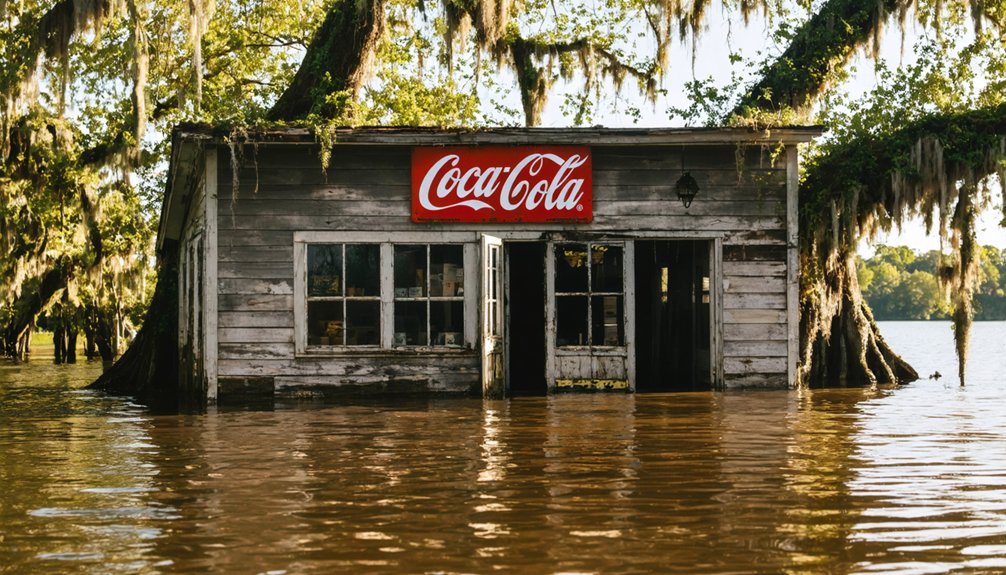
You’ll find compelling stories of resistance among Golden Pond’s final holdouts, with some families choosing to burn their own homes rather than surrender them to TVA’s condemnation process.
TVA’s aggressive land acquisition tactics met fierce opposition from residents who refused initial buyout offers, leading to tense standoffs between federal authorities and local families protecting their ancestral properties. The area that would become Land Between the Lakes eventually displaced thousands from their generational homes.
The last defiant residents finally departed in 1969-1970, many relocating to what would become Little Golden Pond in Calloway County, marking the end of their community’s determined but ultimately futile struggle against displacement.
Community’s Last Stand
The final chapter of Golden Pond’s history unfolded in 1964 when the Tennessee Valley Authority launched its controversial Land Between the Lakes project, sparking fierce resistance from the town’s residents.
Despite their community resilience, nearly 4,700 people across the region were forced to abandon their homes, with Golden Pond’s last residents departing in 1969.
The town’s historical significance lives on through the stories of those who fought to keep their land:
- Families who’d lived there for generations received compensation far below market value, leaving them unable to purchase equivalent properties elsewhere.
- Local businesses, including bait shops, cafes, and motels that had thrived after Kentucky Lake’s creation, were shuttered forever.
- Residents organized protests and legal challenges, though ultimately unsuccessful, demonstrating their unwavering spirit in the face of government intervention.
Burning Before Condemnation
During the final days of Golden Pond’s existence, TVA officials employed increasingly aggressive tactics to clear residents from their ancestral lands, including the controversial practice of burning homes before legal condemnation proceedings were complete.
You’ll find these burning tactics were particularly ruthless – homes would be torched while families were still legally fighting to keep their property through the courts.
The TVA’s strategy created deep community trauma, using physical destruction to break the will of holdouts who hadn’t accepted their inadequate compensation offers.
While residents didn’t respond with violence, they watched helplessly as government bulldozers systematically erased their town, destroying not just buildings but also gardens and other personal landmarks.
Even timber value was deducted from already low property assessments if landowners tried to salvage what they could.
Defiant Families’ Final Choices
Faced with imminent displacement, Golden Pond’s defiant families responded to TVA’s aggressive tactics through varied forms of resistance and adaptation.
Through their emotional resilience, residents made defiant choices to stay until the last possible moment, turning their final days into acts of silent protest against government overreach.
Some families maximized their remaining time by harvesting timber or maintaining businesses along US 68, while others banded together to create new communities like Little Golden Pond.
- Families who refused to leave their ancestral homes until forcibly removed, even as demolition crews approached
- Communities preserving their cultural identity by relocating together and maintaining traditional customs
- Residents documenting their stories through oral histories and interviews, ensuring their legacy of resistance wouldn’t be forgotten
Paranormal Activity and Local Legends
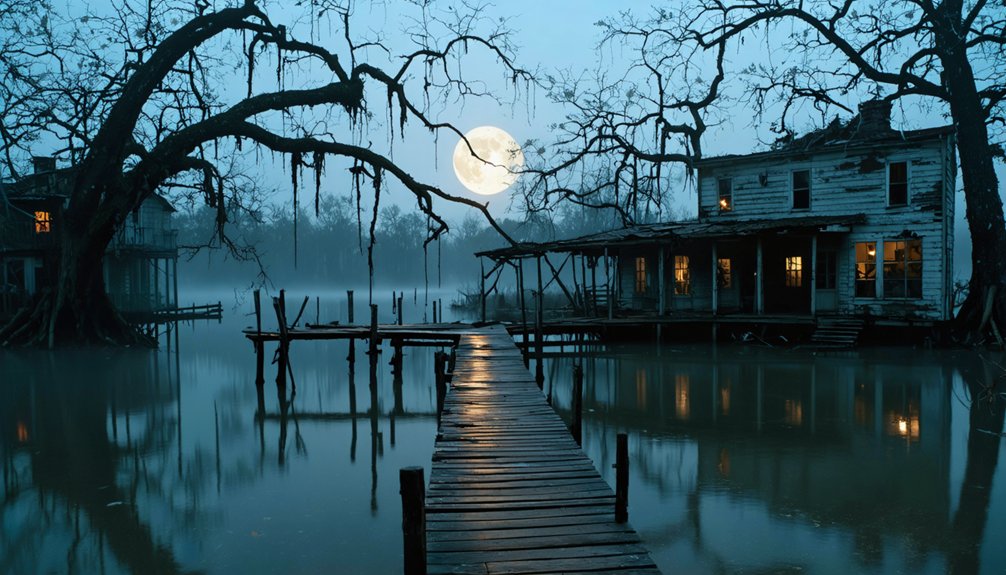
Since its submergence beneath the waters of Lake Barkley in the 1960s, Golden Pond has garnered a reputation as one of Kentucky’s most enigmatic paranormal hotspots.
You’ll find reports of ghostly encounters throughout the area, from mysterious lights glowing beneath the lake’s surface to spectral sightings along The Trace. Visitors regularly report hearing disembodied voices calling from underwater, while paranormal investigators document unexplained temperature drops and moving shadows near the old town site.
The area’s haunted reputation stems from its tumultuous past, including two devastating fires and its history as a moonshine hub during Prohibition. Local legends suggest the forced evacuation of residents in the 1960s left a lasting spiritual imprint, with many former inhabitants’ descendants believing their ancestors still wander these shores.
What Remains: Physical Traces and Memories
If you walk around the former site of Golden Pond today, you’ll find only two concrete mounting blocks remaining from the original downtown area, once used by residents to mount their horses.
The town’s physical traces were largely erased during the 2009-2010 widening of US 68/80, which buried features like the historic flower garden under feet of dirt and gravel.
Much of the original townsite now lies underwater, though metal detectorists continue to discover artifacts like porcelain doorknobs, old buckles, and bricks in the nearby riverbeds.
Concrete Mounting Blocks Remain
Among the few physical remnants of Golden Pond, Kentucky, the concrete mounting blocks stand as silent witnesses to the town’s vanished past.
You’ll find these enduring structures in what was once the bustling downtown, where they served as steps for residents mounting their horses. Their mounting block significance extends beyond their practical purpose – they’re now touchstones connecting displaced families to their roots.
- These simple concrete steps survived two major fires, forced evacuations, and systematic demolition
- They represent the last tangible evidence of daily life in a community erased by government mandate
- You can still visit these mounting blocks today, standing defiant against time where streets and homes once thrived
The blocks remain a powerful symbol of community connection, drawing former residents and their descendants who seek to maintain ties to their heritage.
Underwater Town Site Today
Beyond those steadfast mounting blocks, the physical traces of Golden Pond now rest beneath the waters of Kentucky Lake and Lake Barkley.
You’ll find most submerged remnants hidden under decades of lake sediment, though during periods of low water, you might glimpse hints of the town’s original street layout and foundations. While underwater exploration won’t reveal many intact structures, you can still trace the town’s footprint by comparing historical maps to today’s terrain.
Above the waterline, you’ll discover the original “golden pond” near the visitor center, along with historic road alignments that once led into town.
The memorial overlook offers you a commanding view of the submerged site, where interpretive panels help you envision the bustling community that once stood there.
Preserving Golden Pond’s Heritage Today
Although Golden Pond no longer exists as a physical town, dedicated efforts preserve its heritage through various memorials and historical initiatives within the Land Between the Lakes National Recreation Area.
The spirit of Golden Pond lives on through memorials and exhibits, keeping its legacy alive within Land Between the Lakes.
You’ll find a memorial overlook on the ridge above Highway 68/80, where interpretive panels tell stories of the town’s past. The Golden Pond Visitor Center maintains exhibits showcasing local history, while former residents keep community storytelling alive through reunions and documented oral histories.
- The haunting remains of two concrete mounting blocks from downtown serve as silent witnesses to a once-thriving community.
- Former residents’ stories of displacement and resilience echo through generations of family networks.
- Heritage preservation efforts blend historical documentation with paranormal intrigue, drawing visitors to explore the area’s rich past.
Frequently Asked Questions
What Was the Average Annual Income of Golden Pond Residents?
While exact average income isn’t documented, you’d have earned modest wages from timber, farming, and small businesses, with economic factors suggesting earnings similar to other rural Western Kentucky communities of the mid-1900s.
How Many Churches and Schools Existed in Golden Pond?
While church architecture and education history records aren’t definitive, you’ll find historical evidence suggests at least one schoolhouse and one church existed, though exact numbers weren’t documented before the town’s forced evacuation.
Were There Any Notable Crimes or Lawsuits in Golden Pond’s History?
You’ll find that legal disputes mainly centered on eminent domain cases during forced relocation, while crime history primarily involved moonshining operations during Prohibition, supplying whiskey to major Midwestern cities.
What Native American Tribes Originally Inhabited the Golden Pond Area?
Like ancient footprints in time’s sands, you’ll find the Shawnee were most prominent, while Cherokee and Chickasaw tribes also called this land home. The Mississippian and Fort Ancient peoples preceded them.
Did Any Famous People Ever Visit or Live in Golden Pond?
You won’t find any documented celebrity sightings or famous visitors in Golden Pond’s history. The town’s notable residents were mainly local business owners, farmers, and workers in timber and iron industries.
References
- https://www.wkms.org/society/2016-10-31/golden-pond-lives-in-memories-of-former-residents-and-new-overlook
- https://www.fromthegroundupbooks.com/post/5-most-haunted-places-near-louisville-exploring-land-between-the-lakes-paranormal-history
- https://www.fourriversexplorer.com/golden-pond-kentucky/
- https://www.ajlambert.com/history/jfh_hfo.pdf
- https://en.wikipedia.org/wiki/Golden_Pond
- https://kids.kiddle.co/Golden_Pond
- https://digitalcommons.murraystate.edu/cgi/viewcontent.cgi?article=1099&context=jphs
- https://www.hmdb.org/m.asp?m=123648
- https://kentuckylakehistory.wordpress.com/2011/12/09/the-history-of-kentucky-lake-lake-barkley-and-land-between-the-lakes/
- https://history.ky.gov/markers/golden-pond
